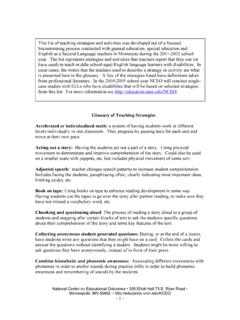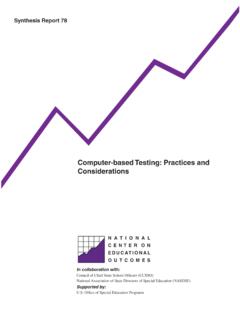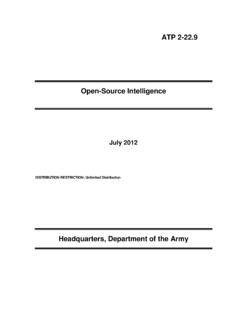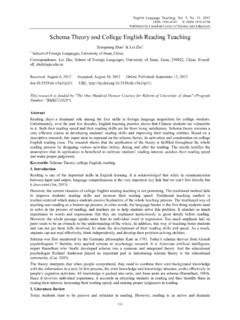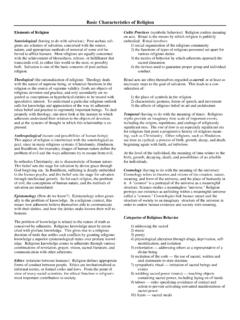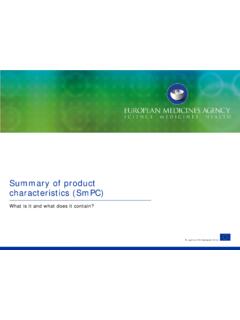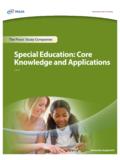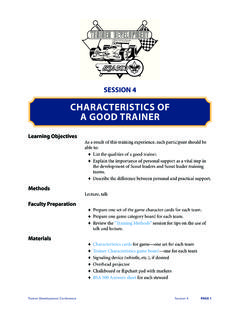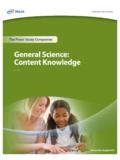Transcription of Principles and Characteristics of Inclusive Assessment …
1 Principles and Characteristics of Inclusive Assessment Systems in a Changing Assessment LandscapeIn collaboration with:Council of Chief State School Officers (CCSSO)National Association of State Directors of Special Education (NASDSE)Supported Office of Special Education ProgramsNCEO Report 400 NCEO Report 400 Principles and Characteristics of Inclusive Assessment Systems in a Changing Assessment LandscapeMartha L. Thurlow, Sheryl S. Lazarus, Laurene L. Christensen, and Vitaliy ShyyanJanuary 2016 All rights reserved. Any or all portions of this document may be reproduced and distributed without prior permission, provided the source is cited as:Thurlow, M. L., Lazarus, S. S., Christensen, L. L., & Shyyan, V. (2016). Principles and Characteristics of Inclusive Assessment systems in a changing Assessment landscape (NCEO Report 400). Minneapolis, MN: University of Minnesota, National Center on Educational Center on Educational OutcomesUniversity of Minnesota 207 Pattee Hall150 Pillsbury Dr.
2 SE Minneapolis, MN 55455 Phone 612/626-1530 Fax 612/624-0879 University of Minnesota shall provide equal access to and opportunity in its programs, facilities, and employment without regard to race, color, creed, religion, national origin, gender, age, marital status, disability, public assistance status, veteran status, sexual orientation, gender identity, or gender document is available in alternative formats upon Core StaffMartha L. Thurlow, DirectorDeb A. AlbusLaurene L. ChristensenLinda GoldstoneSheryl S. LazarusKristi K. LiuMichael L. MooreRachel F. QuenemoenChristopher RogersVitaliy ShyyanYi-Chen WuThe Center is supported through a Cooperative Agreement (#H326G110002) with the Research to Practice Division, Office of Special Education Programs, Department of Education. The Center is affiliated with the Institute on Community Integration at the College of Education and Human Develop-ment, University of Minnesota.
3 The contents of this report were developed under the Cooperative Agreement from the Department of Education, but does not necessarily represent the policy or opinions of the Department of Education or Offices within it. Readers should not assume endorsement by the federal government. Project Officer: David EgnorAcknowledgmentsThis document would not have been possible without the dedication and expertise of all NCEO staff. Their continued analyses of current Assessment practices, and what could be done to improve those practices is the basis for the Principles and Characteristics identified here. In addition to the authors, appreciation is due to (in alphabetical order): Debra Albus, Linda Goldstone, Kristin Liu, Michael Moore, Rachel Quenemoen, Christopher Rogers, and Yi-Chen NCEO Principles were reviewed by multiple stakeholders who share the common goal of improv-ing outcomes for all students. These valued stakeholders were the NCEO Advisory Committee and the NCEO Community of Practice (CoP).
4 NCEO s Advisory Committee includes representatives of several states, researchers, and stakeholder technical assistance providers and representatives. NCEO s CoP members are representatives of national and regional technical assistance partners. They contributed through monthly discussions of Inclusive Assessment and accountability issues and opportunities. These individuals and groups are identified here. Each of these valued partners improved this report substantially; any errors remaining are ours. NCEO Advisory CommitteeTrinell Bowman, Maryland Department of EducationGail Fitzgerald, University of Missouri, retiredConnie Hawkins, Exceptional Children Assistance CenterDirk Mattson, Educational Testing ServiceMargaret McLaughlin, University of MarylandJudy Park, Utah Department of Education, retiredMary Ann Snider, Rhode Island Department of EducationJames Wendorf, National Center on Learning DisabilitiesMarkay Winston, formerly with the Chicago Public SchoolsNCEO Community of PracticeCenter on Standards and Assessment Implementation (CSAI)Council of Chief State School Officers (CCSSO)IDEA Data Center (IDC)National Association of State Directors of Special Education (NASDSE)National Center on Systemic Improvement (NCSI)National Center for Technical Assistance on Transition (NTACT)Office of Elementary and Secondary Education (OESE)Office of Special Education Programs (OSEP)
5 Executive SummaryThe National Center on Educational Outcomes (NCEO) revisited and revised its 2008 Principles for Inclusive Assessment systems to respond to the many changes in the current educational Assessment context. The revised Principles reflect a broader perspective that acknowledges that the Principles should apply not only for students with disabilities but also for English learners (ELs) and ELs with disabilities, as well as to all types of assessments in Assessment systems. As before, the Principles provide a vision of an Inclusive system of assessments. They address na-tional, state, district, school, and classroom K-12 academic content assessments and assessments of English language proficiency. This report presents six core Principles , each with a brief rationale, and specific Characteristics that reflect each principle. The Principles are:Principle 1: Every policy and practice reflects the belief that all students must be included in state, district, and classroom 2: Accessible assessments are used to allow all students to show their knowledge and skills on the same challenging 3: High-quality decision making determines how students participate in 4: Implementation fidelity ensures fair and valid Assessment 5: Public reporting content and formats include the Assessment results of all 6: Continuous improvement, monitoring, and training ensure the quality of the overall of Contents Acknowledgments.
6 IiiExecutive Summary ..vNeed for Revised Principles ..1 Principle 1 ..4 Principle 2 ..7 Principle 3 ..10 Principle 4 ..13 Principle 5 ..15 Principle 6 ..20 Summary Comments ..231 NCEONeed for Revised PrinciplesEducational reform continues to evolve in focus, with greater emphasis now than ever before placed on serving all students on their pathway to college and careers and 21st century skills. The renewed emphasis on all students includes students with disabilities, English learners (ELs), and ELs with disabilities, as well as other groups targeted for attention (including traditionally underserved students such as minority and low income students, students in juvenile detention and mental health facilities, and other students who are struggling in school). Rapid techno-logical changes in instruction and Assessment offer expanded opportunities for new approaches to providing access to all students in the nation s classrooms.
7 The push to include all students comes at the same time as new and more rigorous, internationally competitive standards are being implemented, and greater accountability is required of administrators and educators who work within schools, of special education systems (through results-based accountability), and of students themselves. Interim, benchmark, and other non-summative assessments now appear on the landscape with much greater frequency. Computer adaptive assessments sometimes are replacing traditional summative assessments. And, more is being asked of the assessments that are used. For example, assessments are being used to calculate growth of students rather than just the status of their performance. States are developing new technology-based assessments, creating a much more complex focus on accessibility. So too has the focus on Assessment participation of all students become more complex. Increasingly, discontent is growing among parents, educators, and other stakeholders about too much testing and the desire to opt their children out of document is the fourth in a series of Principles documents produced by the National Center on Educational Outcomes (NCEO).
8 Similar to previous documents, it is designed to identify the Principles and Characteristics of Inclusive Assessment systems. NCEO s previous Principles documents were: A principled approach to accountability assessments for students with disabilities (Synthesis Report 70, December 2008) Principles and Characteristics of Inclusive Assessment and accountability systems (Synthesis Report 40, November 2001) Assessment guidelines that maximize the participation of students with disabilities in large-scale assessments: Characteristics and considerations (Synthesis Report 25, October 1996)An update was deemed needed at this time because of the dramatically changing landscape sur-rounding educational assessments over the past several years. This document identifies Principles of an Inclusive Assessment system within the current educational context. Using this document, 2 NCEO states, districts, schools, and other stakeholders can develop and implement new assessments, or review and adjust their current assessments, in ways that ensure the inclusion of all students, especially students with disabilities, ELs, and ELs with disabilities.
9 The six Principles in this document are intended to offer a vision of an Inclusive Assessment system that aligns with the new educational context of college and career standards, greater use of technology, new uses of assessments, and new approaches to developing assessments. Each principle is further described through a set of Characteristics that provide additional information on implementation and six Principles were developed to address students with disabilities, ELs, and ELs with dis-abilities. Nevertheless, we believe that these Principles also inform Assessment development, Assessment revisions, and decision-making processes for students who do not have disabilities or are not foundational premise of this document is the belief that students with disabilities, ELs, and ELs with disabilities should achieve the same academic outcomes and be held to the same stan-dards as their peers. It is grounded in the belief that assessments can be designed, implemented, evaluated, and improved over time to ensure that they support reliable and valid interpretations for all students, including students with disabilities, ELs, and ELs with disabilities.
10 Although effective instruction and high-quality professional development are important components of this process, the purpose of this document is to focus on assessments. The report addresses the application of the Principles to national, state, district, school, and classroom K-12 academic content and language proficiency Assessment systems. These are assessments of reading/English language arts, mathematics, science, social studies, and any other academic content that states or districts might assess. The Principles also apply to assessments used to screen for and to determine the English language proficiency of ELs and ELs with Principles described in this document address standards-based assessments administered in classrooms, schools, districts, and states. The six Principles described in the document also apply to K-12 academic and language assessments in groups of states with common assess-ments.

